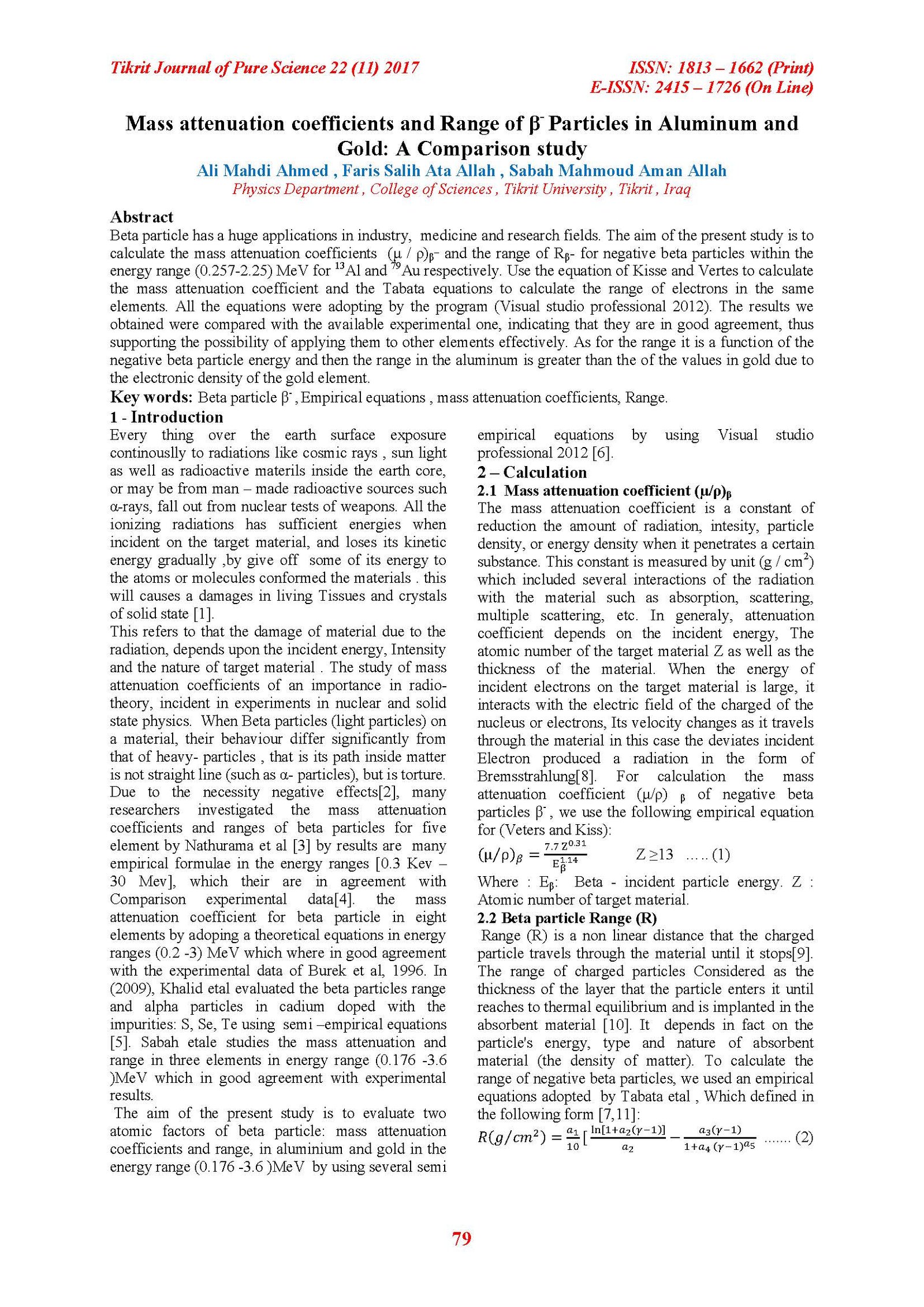Mass attenuation coefficients and Range of β- Particles in Aluminum and Gold: A Comparison study
Main Article Content
Abstract
Beta particle has a huge applications in industry, medicine and research fields. The aim of the present study is to calculate the mass attenuation coefficients (μ / ρ)β_ and the range of Rβ- for negative beta particles within the energy range (0.257-2.25) MeV for 13Al and 79Au respectively. Use the equation of Kisse and Vertes to calculate the mass attenuation coefficient and the Tabata equations to calculate the range of electrons in the same elements. All the equations were adopting by the program (Visual studio professional 2012). The results we obtained were compared with the available experimental one, indicating that they are in good agreement, thus supporting the possibility of applying them to other elements effectively. As for the range it is a function of the negative beta particle energy and then the range in the aluminum is greater than the of the values in gold due to the electronic density of the gold element.
Article Details

This work is licensed under a Creative Commons Attribution 4.0 International License.
Tikrit Journal of Pure Science is licensed under the Creative Commons Attribution 4.0 International License, which allows users to copy, create extracts, abstracts, and new works from the article, alter and revise the article, and make commercial use of the article (including reuse and/or resale of the article by commercial entities), provided the user gives appropriate credit (with a link to the formal publication through the relevant DOI), provides a link to the license, indicates if changes were made, and the licensor is not represented as endorsing the use made of the work. The authors hold the copyright for their published work on the Tikrit J. Pure Sci. website, while Tikrit J. Pure Sci. is responsible for appreciate citation of their work, which is released under CC-BY-4.0, enabling the unrestricted use, distribution, and reproduction of an article in any medium, provided that the original work is properly cited.
References
[3] Natha ram , Is Sundar rao and M k Mehtha,"Mass
absorption coefficients and range of beta particles in
Be, Al, Cu ,Ag and pb", pramana,Vol.18, No.2,
pp.121-126, India, (1982).
[4]R.Burek and D.chocyk, "Baisic Aspect of The
Mass Absorption coefficient of Beta – particles",
Journal of Radioanalytical and Nuclear Chemistry,
Articles, Vol. 209, No. 1 ,pp. 181-191, Budapest,
(1996).
[6] Sabah M. aman Allah, yassen H. Mahmoud,
Abdual H. G. Mardan and Abdual H. shakour," Mass
absorption coefficients and range of multi –energetic
beta particles for some elements: comparative study" ,
p.p 22-23, phy. Dep., college of sciences –Tikrit Uni.,
A 21 scientific conference of college of education -
Munstansaryia University,22-23 April ,p . Box.0:42,
phy. Dep.,(2015).
[7] Esam M.A. Hussen "Radiation Mechanics
Principles and Practice", Elsevier The Boulevard,
Langford Lane, Kidlington, Oxford OX5 1GB,UK
Radarweg 29, PO Box 211, 1000 AE Amsterdam,
The Netherlands First edition Copyright © 2007
Elsevier Ltd. All rights reserved (2007).
[8] E.B. Podgorsak, "Radiation oncology
physics",Ahand book for Teachers and students,
Austria,ch.1,p.p 22-25, (2005).
[9] vertes A, Kiss I "Nuclear chemistry", Elsevier,
Amsterdam, (1987).
[11] Tabata, T., ito, R., and okabe, s., Nucl. Instrum.
Meth. 103:85,(1972).
[12]C S Mahajan ,"Mass attenuation coefficients ob
beta particles in elements" science Research Reporter
2(2), p.p.135-141,(2012).
[13] Gurler o, S Yalcin, "A practical method for
calculation of mass attenuation coefficients of B
particles", Annals of Nuclear 32:1918-1925,(2005).
[14] L. DADDI and V. DANGELO, "On the
Identification of B-Emitters by Absorption
Measurements", International Journal of Applied
Radiation and Isotopes, Vol. 14, pp. 97-103,(1963).
